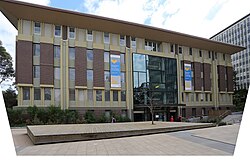
Trinity College is the oldest residential college of the University of Melbourne, the first university in the colony of Victoria, Australia. The college was opened in 1872 on a site granted to the Church of England by the government of Victoria. In addition to its resident community of 380 students, mostly attending the University of Melbourne, Trinity's programs includes the Trinity College Theological School, an Anglican training college which is a constituent college of the University of Divinity; and the Pathways School which runs Trinity College Foundation Studies and prepares international students for admission to the University of Melbourne and other Australian tertiary institutions, as well as summer and winter schools for young leaders and other short courses.

Ormond College is one of the largest residential colleges of the University of Melbourne located in the city of Melbourne, Victoria, Australia. It is home to around 350 undergraduates, 90 graduates and 35 professorial and academic residents.
The purpose of the Monash University Faculty of Arts is 'the pursuit, advancement and application of knowledge in the humanities, social and environmental sciences and creative and performing arts'. It offers degrees from undergraduate to PhD level. Entrance into the undergraduate Bachelor of Arts program is competitive, as it is the most popular Arts degree among university applicants in Victoria.
The Melbourne University Law Review is a triannual law journal published by a student group at Melbourne Law School covering all areas of law. It is one of the student-run law journals at the University of Melbourne and is generally regarded as Australia's leading generalist law journal. Students who have completed at least one semester of law are eligible to apply for membership of the editorial board. Applicants are assessed on the basis of their performance in a practical exercise, academic aptitude, and proofreading and editing skills. The 2024 editors-in-chief are James Cafferky, Alexander Henry and Fiona Xia.
The Castan Centre for Human Rights Law is a research centre located within the Monash University Law Faculty in Victoria, Australia. It was established in 2000 to cater for the study of human rights law globally, regionally and in Australia, and grew rapidly to become the largest research centre in the Monash Law School. As of 2022 it is led by Professor Melissa Castan.

Melbourne Law School is one of the professional graduate schools of the University of Melbourne. Located in Carlton, Victoria, Melbourne Law School is Australia's oldest law school, and offers J.D., LL.M, Ph.D, and LL.D degrees. In 2021–22, THE World University Rankings ranked the law school as 5th best in the world and first both in Australia and Asia-Pacific.
Marcia Ann Neave is an Australian legal academic and judge, who was appointed to the Supreme Court of Victoria, Court of Appeals division on 22 February 2006. She retired from the bench on 23 August 2014 to become commissioner of the Royal Commission into Family Violence.
Lex Lasry is an Australian lawyer and a retired judge of the Supreme Court of Victoria from 2007 to 2018. He also sat as a reserve judge from 2018 until his retirement as a reserve judge in February 2024.
Professor Bryan Horrigan is an Australian legal academic and a past Dean of the Faculty of Law at Monash University in Australia (2013-2024). He previously held positions at Monash University as the Louis Waller Chair in Law and Associate Dean (Research). Formerly a senior associate and long-standing consultant with a leading international law firm, he holds a doctorate in law from Oxford University under a Rhodes Scholarship.
Peter Louis Waller was an Australian jurist. He was particularly well known for his work in evidence, medical and criminal law. He was Sir Leo Cussen Professor of Law at Monash University from 1965 until 2000, and thereafter Emeritus Professor. From 1968 to 1970 he was the Dean of the Faculty of Law at Monash University. From 1982 to 1984 he was the Law Reform Commissioner of Victoria. In 1984 he was appointed the Chairman of the Law Reform Commission, and from 1986 to 1992 he served as a part-time Commissioner. He has also served as the chairman of a number of medical and legal organisations, including the Infertility Treatment Authority, International Humanitarian Law Committee of the Australian Red Cross Society, Ethics Committee of the Walter and Eliza Hall Institute of Medical Research, and the Appeals Committee of the Royal Australasian College of Surgeons. Professor Waller previously served as Visiting Professor and Research Fellow in several universities in the United States, United Kingdom, Canada and Israel.
Sir David Plumley Derham was an Australian jurist and university administrator. He was an expert in Australian constitutional law. In 1963, he became the Foundation Dean of Monash University Law School, which is now called the David Derham School of Law in his honour.
Kevin Harcourt Bell is a former judge of the Supreme Court of Victoria, in the Australian state of Victoria.

The ANU College of Law is the law school at the Australian National University and one of the seven academic Colleges of the ANU. It is located in Canberra, the capital of Australia. This provides the College with opportunities to connect with the work of the Parliament of Australia, the High Court of Australia, the departments and agencies of the Federal Government, as well as the local ACT law-making institutions – the Legislative Assembly and the ACT courts.

The College of Arts, Law and Education was founded in 2017 as a college of the University of Tasmania that incorporated the School of Humanities, the School of Social Sciences, the School of Creative Arts and the Faculties of Law and Education. The College offers undergraduate, postgraduate and research programs.
Richard Michael Niall is an Australian jurist and a judge of the Court of Appeal of the Supreme Court of Victoria. He was appointed to the Court of Appeal in 2017.





